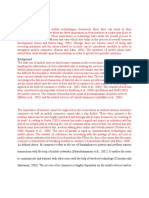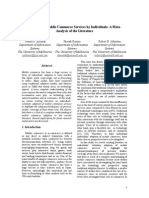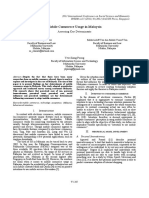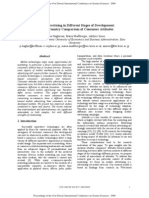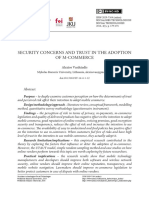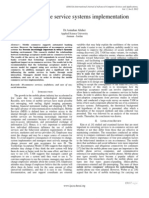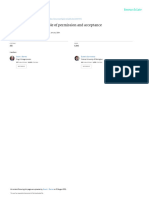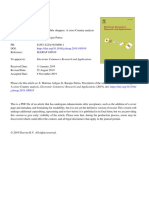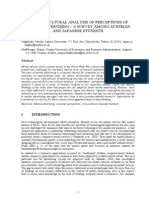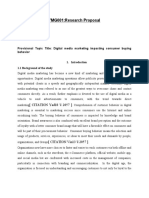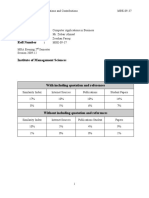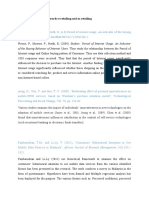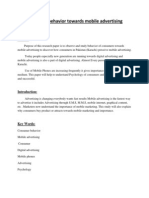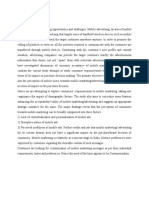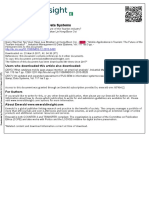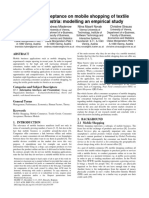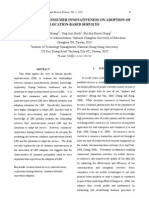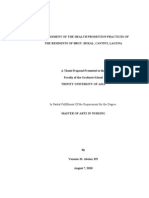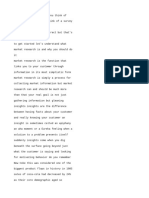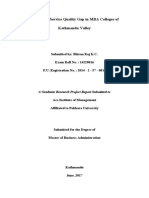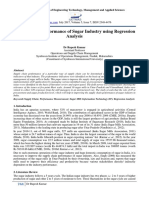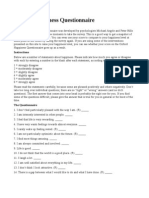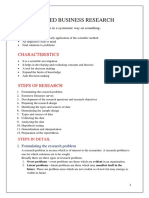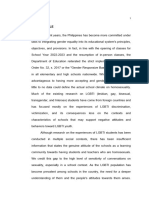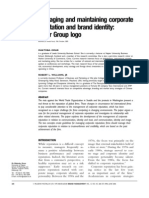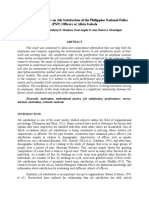BRM Group Project Report
Group 1
Study Effectiveness of
Mobile Advertisements in
the purchase decision
Submitted to Prof. Ravi Shekhar Kumar by
B13080 Bhavya Singla
B13092 Kevin Thomas
B13105 P. R. Rajaram
B13109 Ronak Doshi
B13111 Sandeep Mishra
B13122 Vaibhav Kaushik
Page 1
�BRM Group Project Report
Group 1
Table of Contents
Background of the Study.................................................................................3
Management Decision Problem.......................................................................7
Hypothesis.......................................................................................................7
Research Problem/ Hypothesis/ Research Objective/ Research Questions.7
Questionnaire................................................................................................10
Test Results....................................................................................................13
Conclusion of the study.................................................................................27
Limitations of the Study................................................................................28
References.....................................................................................................28
Page 2
�BRM Group Project Report
Group 1
Background of the Study
Mobile internet applications enable consumers to access a variety of services: Web
information search, SMS (short message service), MMS (multimedia message
service), banking, payment, gaming, e-mailing, chat, weather forecast, GPS (global
positioning service), and so forth. Collectively, this wide array of services is
denominated as "mcommerce." These digital media are considered to potentially
improve the possibilities to reach consumers by allowing personalization of the
content and context of the message. Combining customer's user profile and the
context situation, advertising companies can provide the target customers exactly
the advertisement information they desire, not just "spam" them with irrelevant
advertisements. With a lot of advanced marketing research and analytics tool being
used by many companies it becomes an interesting and valuable study to estimate
what is the level of penetration and effectiveness of mobile advertisements.
Personalization and mobility significantly separate mobile phone (m-commerce)
advertising fromInternet advertising, potentially giving m-commerce the upper
hand. Using advertising based on personalization and geography, firms can identify
a users location precisely and deliver relevantmessages to users. The growth of mcommerce will likely contribute to the advancement of mobileadvertising
techniques and the diversification of services. The traditional pattern of marketing
would be transformed into an interactive one, which implies a move to one-to-one
marketing from one-to-more marketing. This makes our study more relevant and
interesting.
Some of the journals explored this possibility. One of them was Analysis of the
determinants of consumers m-commerce usage activity by Felix T.S. Chan and
Alain Yee-Loong Chong. Its purpose was to examine the factors examining the
determinants of users mobile commerce usage activities. Data was collected from
402 users and structural equation modelling analysis was employed to test the
research model. This research shows that motivational variables have only partial
relationships with m-commerce usage activities. Young users, for example, are more
likely to use m-commerce for content delivery and entertainment purposes. Young
users are more likely to use their mobile devices and engage in activities such as
downloading music, watching videos, and sending messages. However age does
not have significant relationships with transaction and location-based activities.
Therefore activities such as transaction and location-based services are less
commonly used than content delivery and entertainment.
Educational level was found to have a significant positive relationship with
transaction and location-based services. First those who have achieved higher
educational levels might have more spending power, and might be more willing to
purchase using their mobile devices. Contrary to the findings of past studies,
gender has no inuence on the types of m-commerce activities users engage in.
Two intrinsic variables were chosen for this study:
(1) Perceived enjoyment; and (2) Perceived ease of use.
Page 3
�BRM Group Project Report
Group 1
Perceived enjoyment has a significant relationship with all four m-commerce usage
activities. The findings reveal that besides downloading games and listening to
music, which are fun and enjoyable activities, users need to perceive that it is
enjoyable to engage in transactions such as transferring money, purchasing, and
location-based activities, such as receiving mobile advertisements. One reason why
users will use m-commerce to conduct mobile banking, for example, is related to
the perceived usefulness of the activity. Results revealed that users are only
concerned about the security risks involved in transaction and location-based
services. Therefore, users are likely to download music or play mobile games
without worrying about possible security threats.
This study investigated the relationships between demographic profiles, users
motivations and security perceptions, with m-commerce usage activities. The
findings have several implications. First, unlike existing studies of technology
adoption, this study did not focus on whether or not a user will adopt m-commerce.
Instead, it explored the relationships between adoption factors and m-commerce
activities. Second, results included direct relationships between demographic
variables and m-commerce activities, rather than using one as a control variable.
Third, the study reveals that security concerns only affected transaction and
location-based activities. M-commerce providers should improve the security and
privacy features of their systems. Fourth, findings revealed that social inuence can
affect content delivery and entertainment activities. Therefore application providers
can formulate strategies to promote content delivery and entertainment activities
through word of mouth, social network channels, and informal seminars (Wei et al.,
2009). Fifth, results reveal that motivation, in particular intrinsic motivation, plays a
crucial role in users engagement with m-commerce activities. Sixth, this research
has also extended TAM, and applied the enhanced model to study the adoption of
m-commerce usage activities. Finally, based on the results, perceived ease of use
and perceived enjoyment are two of the most important adoption factors, as they
were found to be significant for all m-commerce usage activities.
Another study is Young consumers motives for using SMS and perceptions towards
SMS advertising by Ian Phau and Min Teah. The purpose of it was to examine
young consumers motives for using SMS, their SMS usage frequency and their
attitudes towards SMS advertising. The approach was through convenience
sampling via self-administered questionnaire. A total of 211 samples were collected
and retained for analysis.
SMS advertising presents important future implications for marketers and is
projected to be a booming advertising medium (Carroll et al., 2007; Muk, 2007). In
summary, this paper has identified seven factors that inuence SMS usage.
However, only convenience positively inuences SMS usage frequency, whereas
economic reasons negatively inuence SMS usage frequency, and only social
involvement inuences consumers attitudes towards SMS advertising. There is no
significant relationship between SMS usage frequency and the consumers attitudes
Page 4
�BRM Group Project Report
Group 1
towards SMS advertising. Lastly, attitudes towards SMS advertising is not a
moderator of motives using SMS and SMS usage frequency.
Based on the findings, convenience is paramount in inuencing SMS usage
frequency of the Australian young consumers.
Interestingly, economical reasons negatively inuence SMS usage frequency for
high SMS users. Mobile phone service providers could lower costs to consumers and
in turn will be able to attract more advertising revenue through SMS
advertisements. A cost benefit analysis should be performed to arrive with the best
option of pricing strategies. Social involvement is found as the factor that inuences
consumers attitudes towards advertising. This finding suggests that motivations to
participate in contests, voting on reality shows and to donate to charities are well
accepted as mainstream lifestyle activities and consumers have a positive
acceptance towards such promotions.
It is found that SMS usage frequency does not inuence attitudes towards SMS
advertising. This could be well due to the fact that consumers utilize SMS for the
sake of communication, and probably do not consider it as an advertising channel
as yet. It can be argued that because the market in Australia is relatively new,
marketers would need to be careful in understanding what young consumers would
benefit from SMS ads.
Thus these journals provided some insights into the effectiveness of mobile
advertisements and the various factors that impact user behaviour and how the
mobile advertisements can play a bigger role in user purchase intentions.
3C MODEL FOR E-COMMERCE BUSINESS
The 3C's Model is a business model, which offers a strategic look at the factors
needed for success. The 3Cs model points out that a strategist should focus on
three key factors for success. In the construction of a business strategy, three main
players must be taken into account:
The Customer
The Competitors
The Corporation
Only by integrating these three, a sustained competitive advantage can exist.
COMPETITION
In E-commerce business it is necessary to have an accurate and current
competitive analysis of rival merchants strengths and weaknesses relative to a
corporations own operations, providing a significant advantage or identifying
opportunities.
For small and mid-sized online retailers, a basic competitive analysis should include
a regular, qualitative review of the competitors websites, prices, product mix,
customer service, policies, and marketing. This data can be used both offensively
and defensively to improve our bottom line.
Page 5
�BRM Group Project Report
Group 1
In E-commerce business , the competitor is any company that can affect your profit.
Some competitors may be weak while others may pose an imminent threat to sales
and revenue. To create a competitive analysis, focus should be on those
competitors that are either an immediate threat or that could become a threat
within a year.
To help identify these competitors we should ask two basic questions about our
business and our market.
1. What is our industry segment?
2. Who are our customers?
With this information in hand, we can make a list of potential competitors, by noting
the following.
Any competitor we already know.
Retailers that appear at the top of organic search result pages for important
queries.
Retailers that purchase pay-per-click advertising for industry-specific keywords.
Retailers that advertise in industry-related publications.
Retailers that appear in dealer locators (from suppliers or manufacturers).
Retailers that tweet about the industry on Twitter.
Retailers that post about the topic on Facebook.
Once all the competing e-commerce websites have been identified, the corporate
strategy needs to be designed to gain a competitive advantage over them. Such as
greater advertising, through mobile advertising.
CUSTOMER
Clients are the base of any strategy. Therefore, the primary goal is supposed to be
the interest of the customer. In the long run, a company that is genuinely interested
in its customers will be interesting for its investors and take care of their interests
automatically. Segmentation is one way to help us understand the customer.
Segmenting by objective
The differentiation is done in terms of the different ways that various customers use
a product.
Segmenting by customer coverage
This segmentation normally emerges from a trade-off study of marketing costs
versus market coverage. There appears always to be a point of diminishing returns
in the cost versus coverage relationship. The corporations task is to optimize its
range of market coverage, geographically and/ or channel wise.
Re-segmenting the market
In fierce competition, competitors are likely to be dissecting the market in similar
ways. Over an extended period of time, the effectiveness of a given initial strategic
segmentation will tend to decline. In such situations it is useful to pick a small
group of customers and reexamine what it is that they are really looking for.
A market segment change occurs where the market forces are altering the
distribution of the user-mix over time by inuencing demography, distribution
channels, customer size, etc. This kind of change means that the allocation of
Page 6
�BRM Group Project Report
Group 1
corporate resources must be shifted and/ or the absolute level of resources
committed in the business must be changed.
Customers may choose a E-commerce website for any number of reasons, including
how much they trust the retailer or like the retailers business philosophy. Some of
the factors that consider a customer's decision are:
Contact Information & Customer Service :How easy does your ecommerce
competition make it for their customers to contact them? Do they clearly display
a phone number; make it easy to email them? Have live chat? When you call,
email, or chat, note how quick they are to respond; gauge the quality of the help
you receive.
Purchase :what are various pain points that would cause customers to abandon
their shopping cart. If you see that your ecommerce competition has a poorly
designed conversion funnel making it harder for their customers to make a
purchase, then you can work to ensure it is smooth and quick at your site.
Website aesthetics: how good a site looks impacts how much it is trusted.
Website content. Includes blogs, articles, videos, and product descriptions.
Product selection. Does the site have one type of widget or several to choose
from.
Price. Pricing relative to the market.
Customer service. A site with a phone number might be better than one that
only allows email contact.
Shipping options. Is free shipping available?
Social media presence. It is almost mandatory to have a presence on top
social media sites like Facebook and Twitter. These sites help drive traffic and
increase reputation.
Email marketing. How is email used?
Search engine position. In organic search results what is the position of the
site.
Advertising. Mobile advertisements, Pay-per-click, banners, video, other.
Due to ubiquitous nature of mobile phones, E-commerce websites are finding
mobile advertisements, an effective medium to target the customers.
COMPANY
Top 5
E-commerce websites in India are
Ebay.com
Jabong.com
Myntra.com
Flipkart.com
Snapdeal.com
There are various models of E-commerce such as
Business to business (B2B)
Business to consumer (B2C)
Page 7
�BRM Group Project Report
Group 1
Business to government (B2G)
Consumer to consumer (C2C)
In our research we have focused on Business to consumer (B2C) websites. In the
super competitive industry, advertising is one of the most important mediums for
the companies to increase and maintain their customer base. Because of ubiquitous
nature of mobile phones, companies are increasing their spend on mobile ads.
Management Decision Problem
Should mobile advertisements be used to promote purchases through e-commerce
websites?
Hypothesis
Research Problem/ Hypothesis/ Research Objective/ Research
Questions
Click on the question number to see the test results and conclusion for each test.
Q No.
Research
Research Objective
Hypothesis
Problem
/Research Question
To determine the
Compare the click through
Mean click through
effectiveness of
ratio of mobile advertising
ratio of Mobile
mobile
with the industry average of
Advertising >=
1
advertisements in 7.14% (source:
Industry Average of
its present form
http://appood.com/blog/aver
7.14%
age-ctr-by-ad-formats)
Compare the effectiveness
Mean click through
across different Indian cities
ratio of Mobile
Advertising across
2
different cities is the
same
To determine
Do users who subscribe to
Users who subscribe
consumer
mobile ads find mobile
to mobile ads find
preferences
advertisements informative?
mobile
3
towards mobile
advertisements
advertising
informative
Consumer perception of
Consumers feel safe
mobile advertisement safety.
when they receive
4
mobile
advertisements
Effect of promotional offers
Users who enjoy
5
received on mobile on buying
receiving
decision
promotional offers on
mobile phones
believe that
promotional Offers
Page 8
�BRM Group Project Report
Group 1
Identify the
factors that affect
the attitude of
users towards
mobile
advertisements
Attitude of consumers towards
mobile advertisements
depend on whether the user
finds advertisements
entertaining, finds
advertisements to make
decisions, finds mobile ads
informative, finds mobile ads
irritating, finds mobile ads
unsafe, uses mobile phone to
purchase products through ecommerce websites
Study user
preference for
receiving
advertisements
Identify whether user prefers
mobile advertisements over
online advertisements (web
based)
Gender affects the attitude
towards mobile
advertisements
Users who download mobile
apps of e-commerce sites get
customized ads
10
11
Identify whether users who
perceive mobile ads as unsafe
find mobile advertisements an
intrusion of privacy
Find whether users who pay
Page 9
that come on mobile
are more attractive
than traditional
media
Perform factor
analysis to group
variables and then
Regression to find
the beta's for each
factor
Hypothesis: If user
finds advertisements
entertaining, finds
advertisements to
make decisions, finds
mobile ads
informative, finds
mobile ads irritating,
finds mobile ads
unsafe, uses mobile
phone to purchase
products through ecommerce websites
will describe the
attitude of user
towards mobile
advertisements
Users prefer mobile
advertisements over
online
advertisements
Males have a higher
positive attitude
towards mobile ads
as compared to
female users
Users who download
mobile applications
of e-commerce
websites receive
customized ads
Users who perceive
mobile ads as unsafe
find mobile
advertisements an
intrusion of privacy
Users who pay extra
�BRM Group Project Report
Group 1
extra to block ads on mobile
aps also use the DND feature
People who subscribe to
mobile advertisements
because they believe that
mobile advertisements help
them make purchase
decisions
12
Study preferences of users for
different types of mobile
advertisements
13
14
How many ads
per day would
users want to
receive
Will users prefer to receive
less than an average of 2.5
ads per day
Page 10
to block ads on
mobile aps use the
DND feature
Users who believe
that mobile
advertisements help
them make purchase
decisions subscribe
to mobile
advertisements
Users have equal
preferences for all
the three types of
mobile
advertisements (sms,
ash, in-application
ad)
Users prefer to
receive less than 2.5
ad per day
�BRM Group Project Report
Group 1
Questionnaire
Q1 Please answer the following questions regarding advertisements on mobile
phone by e-commerce websites
Highly Agree Neutral Disagre
Agree
(2)
(3)
e (4)
(1)
You have a positive attitude towards Mobile
Advertisements
You enjoy getting promotional offers on your
phone
You prefer getting product information via
advertisements from e-commerce websites on
your mobile phone
You subscribe to offers of your favorite Ecommerce websites
Mobile Advertisements helps to keep you
updated on latest trends on your favorite ecommerce website
Mobile Advertisements are Informative
Mobile Advertisements help make decision on
the go
Mobile Advertisements videos are entertaining
Advertisements on mobile phone are irritating
Advertisements on mobile phone are unsafe
Advertisements on mobile phone violate
privacy
You use your mobile phone for mobile internet
browsing
You use your phone to download e-commerce
shopping application
You purchase items through e-commerce portal
apps on your mobile phones
you prefer online advertisement as a medium
for receiving product information
You receive customized advertisements on your
phone
customized Ads help in your purchase decision
Promotional Offers that come on mobile are
more attractive than traditional media
Page 11
Highly
Disagre
e (5)
�BRM Group Project Report
Group 1
Q3 Tell us about the mobile advertisements you receive on your phone
0 (1)
1 (2)
2 (3)
3 (4)
4 (5)
5 (6)
More
than 6
(7)
On an average how many mobile
advertisements do you get in day
How many SMS ads do you get on
an average in a day?
How many mobile advertisements
do you click on an average in a
day?
How frequently do would you like
to receive ads on your mobile?
Q4 Tell us a little more about the mobile advertisements you receive on your phone
Always (1) Sometimes
Never (3)
(2)
Do you forward attractive mobile Ads to friends
Do you pay extra in an app to block ads?
Do you post advertisements and offers you receive
on your phone on social networking platforms
Do you activate do not disturb to block
advertisements on your mobile phone
Q5 Did you receive any kind of mobile advertisement for the product or ecommerce website before buying it?
Yes
No
If No Is Selected, Then Skip To Q10 Gender
Q6 What type of Advertisement it was
SMS
Flash Ad
Advertisement with applications
Q7 How helpful was the Mobile Ad in your purchase decision
Very helpful
Somewhat helpful
Not Helpful
Q8 The Mobile Ad was deceiving?
Highly Agree (1)
Agree (2)
Neutral (3)
Disagree (4)
Highly Disagree (5)
Page 12
�BRM Group Project Report
Group 1
Q9 Gender
Male (1)
Female (2)
Q10 Age
Q11 City
Q12 Annual Family Income
Above Rs 1 Lac (1)
1 to 2.5 Lac (2)
2.5 to 5 Lac (3)
Above 5 Lac (4)
Q13 Education
Up to Senior Secondary
Graduate
Post-Graduate
Q14 Occupation
Student
Salaried Professional
Self Employed
Page 13
�BRM Group Project Report
Group 1
Test Results
Assumption for significance level: alpha = 0.05
1. Mean click through ratio of Mobile Advertising >= Industry Average
of 7.14%
One-tailed test
One-Sample Statistics
N
CTR
Std.
Deviation
Mean
50 26.4600
30.62226
Std. Error
Mean
4.33064
One-Sample Test
Test Value = 7.14
T
CTR
Sig. (2tailed)
df
4.461
49
Mean
Difference
.000
19.32000
95% Confidence Interval
of the Difference
Lower
10.6172
Upper
28.0228
Conclusion: Since the p-value/2 < 0.05, we accept the hypothesis
that Mean click through ratio of Mobile Advertising >= Industry
Average of 7.14%
Top
Page 14
�BRM Group Project Report
Group 1
2. Mean click through ratio of Mobile Advertising across different cities
is the same
Descriptives
CTR
95% Confidence Interval
for Mean
Mean
Mumb
ai
Delhi
Std.
Deviatio
Lower
n
Std. Error Bound
1
14
.0000
Upper
Bound
Maximu
Minimum m
.00
.00
23.071 29.2166
4
0
7.80847
6.2023
39.9406
.00
75.00
32.000 28.1780
11.50362
0
1
2.4290
61.5710
.00
67.00
Chenn
ai
Kolkat
a
29
27.862 32.6121
1
4
6.05592
15.4571
40.2671
.00
100.00
50
26.460 30.6222
0
6
4.33064
17.7572
35.1628
.00
100.00
Total
ANOVA
CTR
Sum of
Squares
Between
Groups
Mean
Square
Df
1102.043
367.348
Within Groups
44846.377
46
974.921
Total
45948.420
49
Sig.
.377
.770
Conclusion: Since the p value > 0.05, we can say that the attitude of
consumers vary across the different cities.
Top
3. Users who subscribe to mobile ads find mobile advertisements
informative
Two-tailed test
Page 15
�BRM Group Project Report
Group 1
Paired Samples Statistics
Mean
Pair 1 You subscribe to offers of your
favourite E-commerce websites
Mobile Advertisements are
Informative
Std.
Deviation
Std. Error
Mean
3.22
50
1.217
.172
3.04
50
1.177
.167
Paired Samples Correlations
Correlatio
n
Sig.
N
Pair 1 You subscribe to offers of your favourite Ecommerce websites & Mobile Advertisements
are Informative
50
.449
.001
Paired Samples Test
Paired Differences
Mean
Pair 1 You
subscribe
to offers
of your
favourite
Ecommerc
e
websites
- Mobile
Advertise
ments
are
Informati
ve
.180
Df
Sig. (2tailed)
95% Confidence
Interval of the
Std.
Deviatio Std. Error Difference
n
Mean
Lower
Upper
1.257
.178
Page 16
-.177
.537 1.013
49
.316
�BRM Group Project Report
Group 1
Conclusion: As p value is greater than 0.05 we reject the hypothesis
that Users who subscribe to mobile ads find mobile advertisements
informative
Top
4. Consumers feel safe when they receive mobile advertisements
Two-tailed test
We compare users response to whether they feel unsafe with mobile ads with a
mean of 2. A value more than 2 implies users perceive mobile ads as safe. We use a
one-sample t-test.
One-Sample Statistics
N
Advertisements on
mobile phone are
unsafe
Std.
Deviation
Mean
49
2.84
Std. Error
Mean
.943
.135
One-Sample Test
Test Value = 2.5
t
Advertisements
on mobile phone
are unsafe
Sig. (2tailed)
Df
2.499
48
.016
Mean
Difference
.337
95% Confidence
Interval of the
Difference
Lower
Upper
.07
.61
Conclusion: Since p value is less than 0.05 we accept the hypothesis
that consumers feel safe when they receive mobile advertisements
Top
5. Users who enjoy receiving promotional offers on mobile phones
believe that promotional offers that come on mobile are more
attractive than traditional media
Two-tailed test
Page 17
�BRM Group Project Report
Group 1
Paired Samples Statistics
Mean
Pair 1 You enjoy getting promotional
offers on your phone
Promotional Offers that come on
mobile are more attractive than
traditional media
Std.
Deviation
Std. Error
Mean
3.30
50
1.359
.192
3.04
50
1.177
.167
Paired Samples Correlations
Correlati
on
Sig.
N
Pair 1 You enjoy getting promotional offers on your
phone & Promotional Offers that come on
mobile are more attractive than traditional
media
50
.464
.001
Paired Samples Test
Paired Differences
Df
Sig.
(2tailed
)
95% Confidence
Std. Std. Interval of the
Devia Error Difference
Mean tion Mean Lower
Upper
Pair 1 You enjoy getting
promotional offers on
your phone Promotional Offers
that come on mobile
are more attractive
than traditional media
.260 1.322
.187
-.116
.636
1.39
1
49
.171
Conclusion: Since the p-value is more than 0.05 we reject the
hypothesis that Users who enjoy receiving promotional offers on
mobile phones believe that promotional offers that come on mobile are
more attractive than traditional media.
Page 18
�BRM Group Project Report
Group 1
Top
6. Hypothesis: If user finds advertisements entertaining, finds
advertisements to make decisions, finds mobile ads informative,
finds mobile ads irritating, finds mobile ads unsafe, uses mobile
phone to purchase products through e-commerce websites will
describe the attitude of user towards mobile advertisements
We have performed factor analysis to group variables and then
Regression to find the beta's for each factor
KMO and Bartlett's Test
Kaiser-Meyer-Olkin Measure of Sampling
Adequacy.
Bartlett's Test of
Sphericity
Approx. Chi-Square
.619
101.804
Df
15
Sig.
.000
Conclusion for KMO and Bartlett's Test: Since Kaiser-Meyer-Olkin
Measure of Sampling Adequacy>0.5, we can do factor analysis
Communalities
Initial
Extractio
n
Mobile Advertisements are Informative
1.000
.827
Mobile Advertisements help make decision on the go
1.000
.723
Mobile Advertisements videos are entertaining
1.000
.463
Advertisements on mobile phone are irritating
1.000
.586
Advertisements on mobile phone are unsafe
1.000
.649
1.000
.496
You purchase items through e-commerce portal apps on your
mobile phones
Extraction Method: Principal Component Analysis.
Page 19
�BRM Group Project Report
Group 1
Total Variance Explained
Initial Eigenvalues
Extraction Sums of
Squared Loadings
Rotation Sums of Squared
Loadings
% of
Cumul
Varianc ative
% of
Cumulati
e
%
Total Variance ve %
Comp
% of
Cumulat
onent Total Variance ive %
Total
1
2.72
2
45.364
45.364
2.722
45.364 45.364 2.160
36.004
36.004
1.02
2
17.039
62.403
1.022
17.039 62.403 1.584
26.400
62.403
.902
15.035
77.438
.662
11.030
88.468
.584
9.727
98.195
.108
1.805 100.000
Extraction Method: Principal
Component Analysis.
Component Matrixa
Component
1
Mobile Advertisements are Informative
.908
.059
Mobile Advertisements help make decision on the go
.820
.226
Mobile Advertisements videos are entertaining
.660
.164
Advertisements on mobile phone are irritating
-.658
.391
Advertisements on mobile phone are unsafe
-.475
.651
.363
.604
You purchase items through e-commerce portal apps on your
mobile phones
Extraction Method: Principal Component Analysis.
a. 2 components extracted.
Page 20
�BRM Group Project Report
Group 1
Rotated Component Matrixa
Component
1
Mobile Advertisements are Informative
.777
-.473
Mobile Advertisements help make decision on the go
.800
-.286
Mobile Advertisements videos are entertaining
.635
-.246
Advertisements on mobile phone are irritating
-.313
.699
Advertisements on mobile phone are unsafe
-.015
.805
.644
.285
You purchase items through e-commerce portal apps on your
mobile phones
Extraction Method: Principal Component Analysis. Rotation Method: Varimax
with Kaiser Normalization.
a. Rotation converged in 3 iterations.
Conclusion of Factor Analysis: Mobile Advertisements are
Informative, Mobile Advertisements help make decision on the go,
Mobile Advertisements videos are entertaining, and You purchase
items through e-commerce portal apps on your mobile phones are part
of component 1 and
Advertisements on mobile phone are irritating and Advertisements on
mobile phone are unsafe are part of component 2
Component Transformation Matrix
Component
.818
-.575
.575
.818
Extraction Method: Principal Component
Analysis.
Rotation Method: Varimax with Kaiser
Normalization.
Now we apply regression on the attitude of customer towards mobile
ads using independent variables as Mobile Advertisements are
Informative and Advertisements on mobile phone are irritating
Page 21
�BRM Group Project Report
Group 1
Variables Entered/Removedb
Variables
Removed
Model Variables Entered
1
Method
Advertisements on mobile phone are
irritating, Mobile Advertisements are
Informativea
. Enter
a. All requested variables entered.
b. Dependent Variable: You have a positive attitude towards Mobile
Advertisements
Model Summary
Mode
l
R
Adjusted R
R Square Square
.675a
Std. Error of
the
Estimate
.456
.433
.962
a. Predictors: (Constant), Advertisements on
mobile phone are irritating, Mobile
Advertisements are Informative
Conclusion of the regression analysis: From the R2 Value of 0.433
we can comment that 43.3% of the value of attitude of customers
towards mobile advertisements can be explained from the two
variables selected for regression.
ANOVAb
Sum of
Squares
Model
1
Mean
Square
df
Regressio
n
36.483
18.242
Residual
43.517
47
.926
Total
80.000
49
Sig.
19.702
.000a
a. Predictors: (Constant), Advertisements on mobile phone are
irritating, Mobile Advertisements are Informative
b. Dependent Variable: You have a positive attitude towards Mobile
Advertisements
Page 22
�BRM Group Project Report
Group 1
Coefficientsa
Model
1
Unstandardized
Coefficients
Standardize
d
Coefficients
Beta
Std. Error
(Constant)
.697
.653
Mobile
Advertisements are
Informative
.762
.131
Advertisements on
mobile phone are
irritating
.080
.151
Sig.
1.067
.291
.702
5.817
.000
.064
.532
.597
a. Dependent Variable: You have a positive attitude towards Mobile
Advertisements
Conclusion: After performing factor analysis and regression, we can
comment that attitude of users towards advertisements depends on
how users perceive advertisements as "informative" or "irritating" with
a beta value of 0.702 and 0.064 respectively.
Top
7. Users prefer mobile advertisements over online advertisements
One-tailed test
Paired Samples Statistics
Mean
Std.
Deviation
Std. Error
Mean
Pair 1 You prefer getting
product information
via advertisements
from e-commerce
websites on your
mobile phone
3.20
50
1.212
.171
you prefer online
advertisement as a
medium for
receiving product
information
2.74
50
1.139
.161
Page 23
�BRM Group Project Report
Group 1
Paired Samples Correlations
Correlatio
n
Sig.
N
Pair 1 You prefer getting
product information
via advertisements
from e-commerce
websites on your
mobile phone & you
prefer online
advertisement as a
medium for
receiving product
information
50
.585
.000
Paired Samples Test
Paired Differences
95% Confidence
Std.
Std. Interval of the
Deviatio Error Difference
Mean n
Mean Lower
Upper
Pair You prefer getting
1
product information
via advertisements
from e-commerce
websites on your
mobile phone - you
prefer online
advertisement as a
medium for
receiving product
information
.460
1.073
.152
.155
.765
3.03
1
Sig.
(2tailed)
Df
49
.004
Conclusion: We see that p value is significant hence we accept the
hypothesis that mobile advertisements are preferred over online
advertisements by users to receive product information
Top
Page 24
�BRM Group Project Report
Group 1
8. Males have a higher positive attitude towards mobile ads as
compared to female users
One-tailed test
Group Statistics
Gender N
You have a positive
attitude towards
Mobile
Advertisements
Std.
Deviation
Mean
Male
Std. Error
Mean
41
3.22
1.194
.186
2.88
1.642
.581
Female
Independent Samples Test
Levene's Test
for Equality
of Variances t-test for Equality of Means
F
You have a
positive
attitude
towards
Mobile
Advertise
ments
Equal
varianc
es
assume
d
Equal
varianc
es not
assume
d
Sig.
2.300
Df
Std.
Mean Error
Sig. (2- Differ Differ
tailed) ence ence
95% Confidence
Interval of the
Difference
Lower
Upper
.136 .701
47
.487 .345 .491
-.644
1.333
.565
8.50
3
.587 .345 .610
-1.047
1.736
Conclusion: From the table above we see that the p/2 value is greater
than 0.05 and hence we reject the hypothesis that males have a
higher positive attitude towards mobile ads as compared to female
users
Top
9. Users who download mobile applications of e-commerce websites
receive customized ads
Two-tailed test
Page 25
�BRM Group Project Report
Group 1
Paired Samples Statistics
Mean
Pair 1 You use your phone to download
e-commerce shopping application
You receive customized
advertisements on your phone
Std.
Deviation
Std. Error
Mean
2.88
50
1.239
.175
2.94
50
1.132
.160
Paired Samples Correlations
Correlati
on
Sig.
N
Pair 1 You use your phone to download e-commerce
shopping application & You receive customized
advertisements on your phone
50
.416
.003
Paired Samples Test
Paired Differences
Mean
Pair 1
You use your
phone to
download ecommerce
shopping
application - You
receive
customized
advertisements
on your phone
-.060
95% Confidence
Std.
Std. Interval of the
Deviatio Error Difference
n
Mean Lower
Upper
1.284 .182
-.425
.305 -.330
Sig. (2tailed)
df
49
.743
Conclusion: Since p value is greater than 0.05 we reject the
hypothesis that users who download mobile applications of ecommerce websites receive customized ads
Top
Page 26
�BRM Group Project Report
Group 1
10.
Users who perceive mobile ads as unsafe find mobile
advertisements an intrusion of privacy
Two-tailed test
Paired Samples Statistics
Mean
Std.
Deviation
Std. Error
Mean
Pair 1 Advertisements on mobile
phone are unsafe
2.84
49
.943
.135
Advertisements on mobile
phone violate privacy
2.49
49
.960
.137
Correlation Sig.
Paired Samples Correlations
Pair 1 Advertisements on mobile phone
are unsafe & Advertisements on
mobile phone violate privacy
49
.665
.000
Paired Samples Test
Paired Differences
Df
Sig. (2tailed)
95% Confidence
Interval of the
Std.
Deviatio Std. Error Difference
Mean n
Mean
Lower
Upper
Pair 1
Advertisem
ents on
mobile
phone are
unsafe Advertisem
ents on
mobile
phone
violate
privacy
.347
.779
.111
.123
.571 3.119
48
Conclusion: As p value is less than 0.05 we accept the hypothesis
that users who perceive mobile ads as unsafe find mobile
advertisements an intrusion of privacy
Page 27
.003
�BRM Group Project Report
Group 1
Top
11.
Users who pay extra to block ads on mobile aps use the DND
feature
Two-tailed test
Paired Samples Statistics
Mean
Pair 1 Do you activate do not disturb to
block advertisements on your
mobile phone
Do you pay extra in an app to
block ads?
Std.
Deviation
Std. Error
Mean
1.88
49
.781
.112
2.67
49
.591
.084
Paired Samples Correlations
Correlati
on
Sig.
N
Pair 1 Do you activate do not disturb to block
advertisements on your mobile phone & Do you
pay extra in an app to block ads?
Page 28
49
.228
.116
�BRM Group Project Report
Group 1
Paired Samples Test
Paired Differences
Std.
Std.
Deviati Error
Mean on
Mean
Pair 1 Do you
activate do
not disturb to
block
advertisemen
ts on your
-.796
mobile phone
- Do you pay
extra in an
app to block
ads?
.866
Sig. (2tailed)
df
95% Confidence
Interval of the
Difference
Lower
.124
Upper
-1.045
-.547
6.437
48
.000
Conclusion: Since p value is greater than 0.05 we accept the
hypothesis that users who pay extra to block ads on mobile aps use
the DND feature
Top
12.
Users who believe that mobile advertisements help them make
purchase decisions subscribe to mobile advertisements
Two-tailed test
Paired Samples Statistics
Mean
Pair 1 Mobile Advertisements help
make decision on the go
You subscribe to offers of your
favourite E-commerce websites
Std.
Deviation
Std. Error
Mean
3.14
50
1.212
.171
3.22
50
1.217
.172
Page 29
�BRM Group Project Report
Group 1
Paired Samples Correlations
Correlatio
n
Sig.
N
Pair 1 Mobile Advertisements help make decision on the go
& You subscribe to offers of your favourite Ecommerce websites
50
.477
.000
Paired Samples Test
Paired Differences
Mean
Pair Mobile
1
Advertiseme
nts help
make
decision on
the go - You
subscribe to
offers of your
favourite Ecommerce
websites
-.080
Std.
Std.
Deviati Error
on
Mean
1.243
Sig. (2tailed)
df
95% Confidence
Interval of the
Difference
Lower
.176
Upper
-.433
.273 -.455
49
.651
Conclusion: Since p-value is not significant the hypothesis is rejected.
So we cannot say that users who believe that mobile advertisements
help them make purchase decisions subscribe to mobile
advertisements
Top
13.
Users have equal preferences for all the three types of mobile
advertisements (sms, flash, in-application ad)
One-Way Anova
Page 30
�BRM Group Project Report
Group 1
Descriptives
How helpful was the Mobile Ad in your purchase decision
N
SMS
95% Confidence Interval
Std.
Deviatio Std. for Mean
Minimu Maxim
Mean n
Error Lower Bound Upper Bound m
um
12 1.58
.900 .260
1.01
2.16
Flash Ad
5 2.40
.548 .245
1.72
3.08
Advertisement
with
applications
5 2.00
.707 .316
1.12
2.88
22 1.86
.834 .178
1.49
2.23
Total
ANOVA
How helpful was the Mobile Ad in your purchase
decision
Sum of
Squares
Between
Groups
Mean
Square
df
2.474
1.237
Within Groups
12.117
19
.638
Total
14.591
21
Post HOC
Page 31
Sig.
1.940
.171
�BRM Group Project Report
Group 1
Multiple Comparisons
How helpful was the Mobile Ad in your purchase decision
LSD
(I) What type
of
(J) What type of
Advertisement Advertisement it
it was
was
SMS
Flash Ad
Mean
Difference
(I-J)
95% Confidence
Interval
Std.
Error Sig.
Lower
Bound
Upper
Bound
Flash Ad
-.817 .425 .070
-1.71
.07
Advertisement
with applications
-.417 .425 .339
-1.31
.47
SMS
.817 .425 .070
-.07
1.71
Advertisement
with applications
.400 .505 .438
-.66
1.46
.417 .425 .339
-.47
1.31
-.400 .505 .438
-1.46
.66
Advertisement SMS
with
Flash Ad
applications
Conclusion: We see that the preference of users for the three ads is
different. And from the LSD we see that SMS and advertisement with
applications and SMS with Flash ads have variances which are
significantly different.
Top
14.
Users prefer to receive less than 2.5 ad per day
One-tailed test
One-Sample Statistics
N
How frequently do
would you like to
receive ads on your
mobile?
Std.
Deviation
Mean
48
2.00
Page 32
1.185
Std. Error
Mean
.171
�BRM Group Project Report
Group 1
One-Sample Test
Test Value = 2.5
t
How frequently do would
you like to receive ads on
your mobile?
-2.923
Sig. (2tailed)
Df
47
.005
95% Confidence
Interval of the
Difference
Mean
Difference Lower
-.500
Upper
-.84
Conclusion: Since, P value is <0.025 we accept the hypothesis: Users
prefer to receive less than 2.5 ad per day
Conclusion of the study
Based on our research and testing of sample data we can conclude that:
1. Users who find mobile ads informative have a positive attitude towards mobile
advertisements.
2. Users who find mobile ads unsafe find it an intrusion of privacy. Mobile
advertisers should work on this further to find way to change the user
perception of mobile ads to safe and un-intrusive medium of communication
information.
3. Users enjoy getting latest product information on their favourite e-commerce
websites.
4. Users prefer to receive lesser number of ads per day, an average of 2 ads per
day.
5. Mobile advertisements should be targeted to help user make purchase
decisions.
6. Users who download mobile applications of their preferred e-commerce
websites do not receive customized ads. This should we worked upon and ads
based on individual user preferences should be used
7. Users do not prefer to pay extra to block ads on mobile applications. This shows
that user don't mind getting ads on their mobile applications. Mobile application
should be the preferred way to go for e-commerce websites to advertise on
mobile platforms
8. Users find promotional offers available through online media better than the
mobile media. Mobile advertisers should look at better promotional offers via
mobile applications and advertisements for the e-commerce websites
9. Click-through ratio is higher than the industry standard for our survey for mobile
advertisements. Refer to limitations section to understand why it may be so.
Page 33
-.16
�BRM Group Project Report
Group 1
Limitations of the Study
1. We do not have sufficient data to calculate the click-through ratio and hence
have not inferred any findings from the tests on click-through ratio. We need at
least a sample of 2000+ people to accurately comment on click-through ratio.
2. Surveys were the primary method of research used in this study. Surveys have
some inherent limitations as a method of research , such as
a. Respondents may not feel encouraged to provide accurate, honest answers
b. Respondents may not feel comfortable providing answers that present
themselves in unfavourable manor.
c. Respondents may not be fully aware of their reasons for any given answer
because of lack of memory on the subject, or even boredom.
d. Data errors due to question non-responses may exist. The number of
respondents who choose to respond to a survey question may be different
from those who chose not to respond, thus creating bias.
e. Survey question answer options could lead to unclear data because
respondents may interpret certain answer options differently. For example,
the answer option somewhat agree may represent different things to
different subjects, and have its own meaning to each individual respondent.
Yes or no answer options can also be problematic. Respondents may
answer no if the option only once is not available.
3. These factors decrease the reliability of the data collected. Further, few
limitations specific to our research were:
a. Small sample size, due to time and resource constraints.
b. Our research mostly focussed on the metropolitans only , and we couldnt
see the penetration of mobile advertisements in the semi-urban areas.
c. The demographic profile of the respondents did not show a great variety.
Hence, the results may be biased to some extent.
References
http://www.valuebasedmanagement.net/methods_3C's.html
http://www.practicalecommerce.com/articles/3301-How-to-Analyze-YourEcommerce-Competitors
http://www.searchenginepeople.com/blog/secret-shoppingcompetition.html#ixzz2wiSDDGTV
Analysis of the determinants of consumers m-commerce usage activity by Felix
T.S. Chan and Alain Yee-Loong Chong
Young consumers motives for using SMS and perceptions towards SMS
advertising by Ian Phau and Min Teah
Page 34



